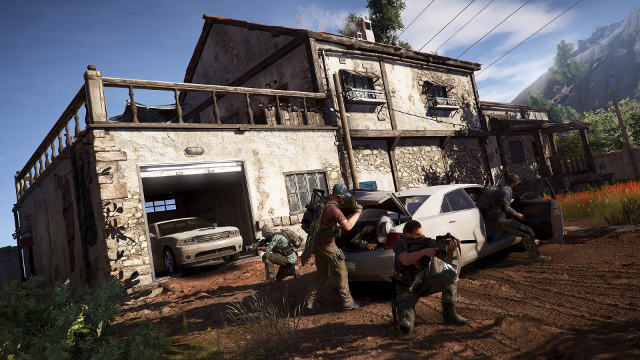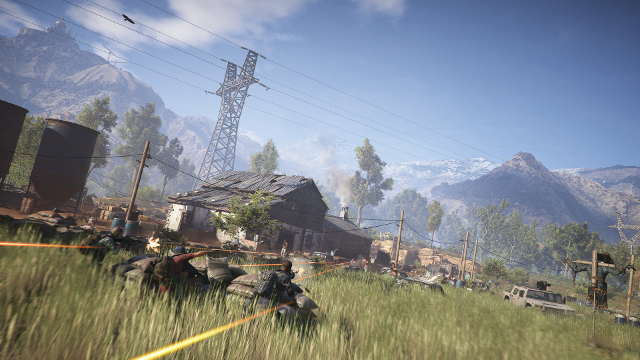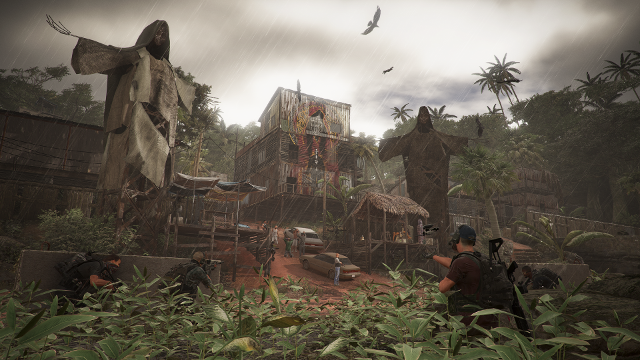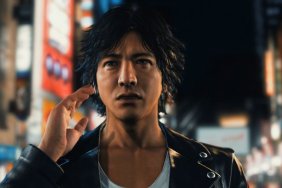Back in the day, Ghost Recon was one of Ubisoft’s hottest titles. With steady releases on consoles and PC, and becoming one of the early online console shooters on Xbox, the series became an admired title among fans of tactical military shooters. With the move to new consoles, Ghost Recon reinvented itself with Advanced Warfighter, becoming one of the more visually impressive games on Xbox 360. But after a few more releases, and one free-to-play title, we’ve been without a major release for a quite sometime.
Thankfully, Ubisoft figured it was time release something new in the Ghost Recon series, and this time they’re seeking to rediscover the series’ roots in its move to the open world space. In development since 2012, the team at Ubisoft Paris have been hard at work at trying to revitalize the series after its last major release. During a special hands-on event, we got to spend about four hours playing the early levels of the campaign, and had a talk with the Lead Gameplay Designer about their vision for bringing Ghost Recon to a new setting and back into the modern day.
Moving away from the future settings of Advanced Warfighter and Future Soldier, Wildlands brings Ghost Recon back to a more gritty and grounded space. Set in Bolivia, the country has been taken over by the Santa Blanca drug cartel. With its leader El Seuno taking control of the country’s drug trade, buying off police and political officials, and leading an army of sicarios (hitmen) and enforcers, the Santa Blanca’s influence has spread rapidly, causing concern for the US government. Calling in a special forces outfit known as the Ghosts, the U.S. sends these agents to Bolivia to work with the rebel forces fighting against the drug cartel in order to dismantle and overthrow the Santa Blanca organization to prevent their growth into North America and overseas.
Over the last decade, the Ghost Recon franchise focus on more a near-futuristic interpretation of modern conflict sort of stretched the believability the series once had. Soldiers had cloaking devices and AI robot companions, and their missions tended to focus more on futurist interpretations of what global conflicts could happen in the years ahead. With Wildlands, the developers wanted to go back to the roots of the Ghost Recon franchise, focusing on a more present day feel, and with a more tangible conflict to overcome. And the extremity of the drug trade in South America definitely serves a relevant setting for Wildlands.

Speaking with Dominic Butler, lead gameplay designer on Wildlands, he spoke about their approach to tone and how they wanted to give believability to the series.
“For us, the idea of bringing it to a more modern time, set two years from now, it’s meant to say that when we were approaching it, we wanted to show that we did our research,” said the lead gameplay designer. “It’s a Tom Clancy game, so of course people expect a certain level of authenticity in terms of weapons, but also the kind of weapons found in the region of the world. But it also extends to drones and things like that. We’ve got a little bit of leeway, we’re not using any super futuristic type of gear, and what it does is give us a good grounding in reality. We wanted to bring Bolivia and this beautiful open world to life.”
When you start a new campaign, you’re given a quick opener about the situation in Bolivia, the key players in the Santa Blanca cartel, and who your allies are. After that, you’ll create your character. Choosing from either male or female, you can customize them as you see fit, and they’ll be fully voiced for all interactions between characters. Over the course of the campaign, you’ll aqcuire new cosmetic items and gear, which you can use to decorate your character with.
Once you’re on your first mission, you’ll be introduced to your three new AI partners. Each one has their own personality and the banter that your squad has with one another was surprisingly amusing. If these guys give you too much grief, you’ll be pleased to know that you’ll be able to play the entire game in co-op with friends and others online. The Squad dynamics were also very impressive. With the number options you have, you’ll be able to work in tandem with your squad to engage foes in a ton ways. One returning feature is the Sync Shot. By tagging enemies, each member of the squad and line up their shots on their targets — with the in-game hud showing everyone has their mark, the leader gives the order to let the other give off their timed shots. It was rad pulling this off and immediately running in to capture a target for interrogation.
One interesting thing I noticed fairly early on was that there was much more humor, whether intentional or something that sprang up from the ridiculous moments throughout my escapades, in this Ghost Recon title. The Tom Clancy games usually pride themselves on being serious in tone, but this title feels far more loose in terms of what you’ll experience. One moment you’ll be learning about the harrowing account of the cartel using a series of mine shafts that the cartel uses as training camps to train sicarios, the next you’ll be driving around in construction vehicles in tight corridors as you chase down hostiles. According to Butler, it took a lot of work balancing the tone for Wildlands, as the move to open world made it open to having more room to experiment.

“We kind had to be ok with it [balancing tone] because we made the commitment to the freedom of the open world.” said Butler. “Across the board, everyone on the team had that moment of adapting to that new way of thinking. Yes, it does mean dorky fun is going to be had, but it also means you get to be really creative in the challenges we make. Because with the way you choose to do it, there’s really no wrong answers, and that’s a beautiful thing and a lot of fun for us to do.”
And yes, there was much dorky fun to be had exploring Bolivia. Whether using my scout drone to troll enemies, or rolling up guns blazing on a convoy carrying drugs and cash, there’s a lot of variety in how you choose to go about taking on foes. Wildlands places a lot of emphasis on customization, which is vast and surprisingly deep. The Gunsmith feature from Future Solider makes a return, which lets players break down weapons and customize them down to the barrel and decal. Basically letting you tailor your guns to your liking. I ended up settling on an automatic sniper rifle, which felt more like a long range LMG.
Players will also be able to build out their character’s skills and new abilities over the course of the game. When you complete combat challenges, find valuable intel, and complete missions, you’ll unlock skill points which can be used to unlock various tiers for your character’s proficiency in weapons handling, drone controls, item usage, physical attributes, squad abilities, and rebel support — which lets you call in AI support from the local resistance fighting Santa Blanca. I really dug how many options there was to engage the missions. It’s impressive how well designed the world is, allowing you to freely move in and out of story and side missions.
“This is a designer answer, but for me [regarding his favorite part of the game] is getting the systems of the game to work together properly,” said the designer. “We have traffic systems, AI movement, patrols, different factions in conflict, but also as a secondary thing to have them play off each other in organic ways. It’s a lot of moving parts, and when we get stories from people that tell us about this one they did, such attacking a cartel convoy, which caused X, Y, and Z to happen, those stories are truly what we’re most proud of.”

By far, the one thing that the devs are most proud of is the design of the open world. Said to be largest one Ubisoft has ever made, their take on Bolivia stretches across 11 regions, each with differing landscapes — such as jungles, snow capped mountains, salt-flats, and urban environments — other points of interest, and special missions and vehicles designed for their areas. We were only allowed to explore two spaces, but both felt vast enough to a cover an open world the average game, which was thankfully easy to move around in with helicopters and other fast vehicles scattered about. While impressive as it was, it did a bit daunting at first, and I was a little bothered at how aimless things felts when exploring.
You’re given the freedom to move around early on, for better or worse, which makes me feel a bit lost to be honest. This was made worse because of how empty much of the world felt in between. Still, I respect the level of detail present, and the devs were keen on stating how much work it took to create a fully explorable open-world. “We had to completely change our approach to the core of the Ghost Recon experience, which is freedom of choice,” stated Butler. “We didn’t want to put up any artificial borders scattered around the world, we wanted that freedom of movement and progression. We had to make it all work for the narrative, but also for solo and co-op play. These were all questions that were terrifying at the start, but we knew what we had this vision in mind.”
I’m very impressed with how Ghost Recon: Wildlands is shaping up. Though there is the argument that Ubisoft might be focusing too much on open world games, I was very impressed with how hard they went in with this title, and co-op play turned out to be a whole lot of fun for a guy who tends to be more focused on single player content. With its release coming up on March 7, I’m excited to be able to explore more of Bolivia and take down the cartel later this year.







